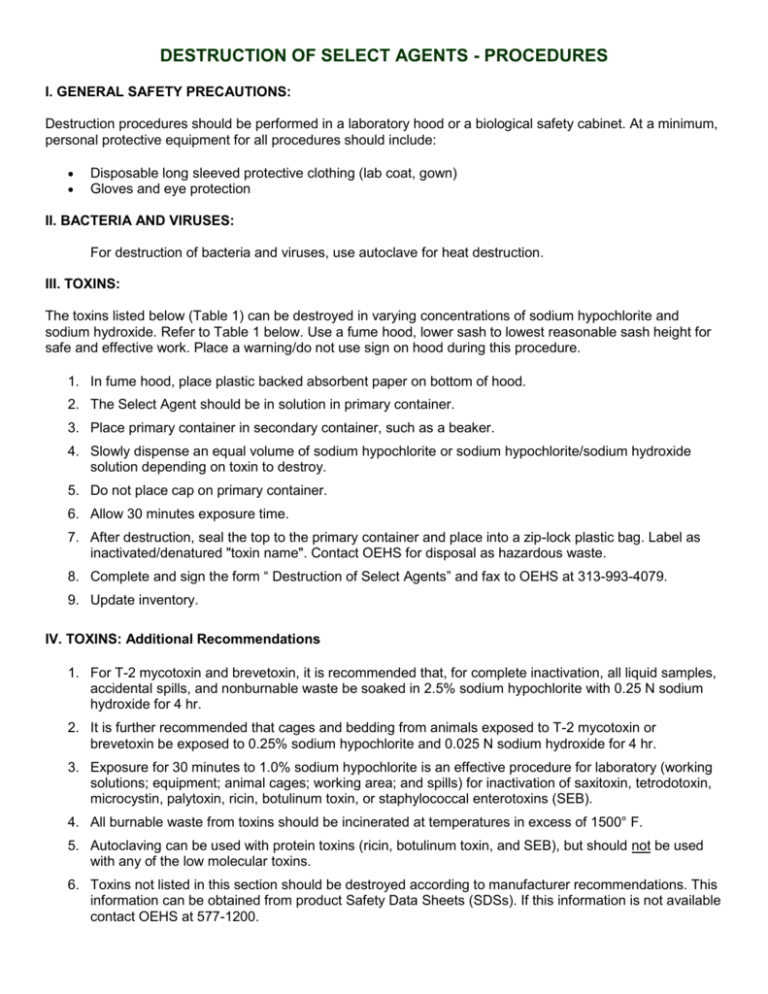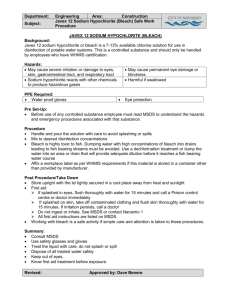Select Agent/Toxin Destruction Procedures
advertisement

DESTRUCTION OF SELECT AGENTS - PROCEDURES I. GENERAL SAFETY PRECAUTIONS: Destruction procedures should be performed in a laboratory hood or a biological safety cabinet. At a minimum, personal protective equipment for all procedures should include: Disposable long sleeved protective clothing (lab coat, gown) Gloves and eye protection II. BACTERIA AND VIRUSES: For destruction of bacteria and viruses, use autoclave for heat destruction. III. TOXINS: The toxins listed below (Table 1) can be destroyed in varying concentrations of sodium hypochlorite and sodium hydroxide. Refer to Table 1 below. Use a fume hood, lower sash to lowest reasonable sash height for safe and effective work. Place a warning/do not use sign on hood during this procedure. 1. In fume hood, place plastic backed absorbent paper on bottom of hood. 2. The Select Agent should be in solution in primary container. 3. Place primary container in secondary container, such as a beaker. 4. Slowly dispense an equal volume of sodium hypochlorite or sodium hypochlorite/sodium hydroxide solution depending on toxin to destroy. 5. Do not place cap on primary container. 6. Allow 30 minutes exposure time. 7. After destruction, seal the top to the primary container and place into a zip-lock plastic bag. Label as inactivated/denatured "toxin name". Contact OEHS for disposal as hazardous waste. 8. Complete and sign the form “ Destruction of Select Agents” and fax to OEHS at 313-993-4079. 9. Update inventory. IV. TOXINS: Additional Recommendations 1. For T-2 mycotoxin and brevetoxin, it is recommended that, for complete inactivation, all liquid samples, accidental spills, and nonburnable waste be soaked in 2.5% sodium hypochlorite with 0.25 N sodium hydroxide for 4 hr. 2. It is further recommended that cages and bedding from animals exposed to T-2 mycotoxin or brevetoxin be exposed to 0.25% sodium hypochlorite and 0.025 N sodium hydroxide for 4 hr. 3. Exposure for 30 minutes to 1.0% sodium hypochlorite is an effective procedure for laboratory (working solutions; equipment; animal cages; working area; and spills) for inactivation of saxitoxin, tetrodotoxin, microcystin, palytoxin, ricin, botulinum toxin, or staphylococcal enterotoxins (SEB). 4. All burnable waste from toxins should be incinerated at temperatures in excess of 1500° F. 5. Autoclaving can be used with protein toxins (ricin, botulinum toxin, and SEB), but should not be used with any of the low molecular toxins. 6. Toxins not listed in this section should be destroyed according to manufacturer recommendations. This information can be obtained from product Safety Data Sheets (SDSs). If this information is not available contact OEHS at 577-1200. V. STAPHYLOCOCCUS ENTEROTOXIN B (SEB), RICIN, BOTULINUM (AUTOCLAVE OPTION) Use autoclave for heat destruction. Autoclaving can be used with protein toxins (ricin, botulinum toxin, and SEB), but should not be used with any of the low molecular toxins. Use autoclave for heat destruction. 1. In a fume hood or biological safety cabinet, loosen cap of primary container. 2. Place primary container into secondary container. 3. Place container into a biohazard autoclave bag. 4. Place bag in autoclavable tray. 5. Autoclave at 121° C for 45 minutes on liquid cycle (slow exhaust). 6. After autoclaving, allow time for materials to cool before handling. 7. Discard as infectious waste. 8. Complete and sign the form: Destruction of Select Agents and fax to OEHS at 313-993-4079. 9. Update inventory. VI. FORM: DESTRUCTION OF SELECT AGENTS Complete the “Destruction of Select Agent” form when destroying a Select Agent. Before you do so, contact OEHS (313-577-1200) to verify the procedure. Destruction of non-exempt registered Select Agents must be reported to the U.S. Centers for Disease Control (CDC). Call OEHS if you have any questions. Fax completed form to OEHS at 313-993-4079. VII. REFERENCES Morin, R.S., and Kozlovac, J.P. 2000. Biological Select Agents, p. 261-272. In D.O. Fleming, and D.L. Hunt (ed.), Biological Safety, Principles and Practices. ASM Press, Washington, D.C. Slein, M.W., and Sansone, E.B. 1980. Degradation of Chemical Carcinogens, An Annotated Bibliography. Van Nostrand Reinhold Company, New York, N.Y. University of North Carolina Stanford University University of Pennsylvania Table 1. Complete inactivation of different toxins with a 30 minute exposure to various concentrations of sodium hypochlorite (NaOCl) and without sodium hydroxide (NaOH) Toxin 2.5% NaOCl + 0.25 N NaOH 2.5% NaOCl 1% NaOCl 0.1%NaOCl T-2 mycotoxin yes no no no Brevetoxin (PbTx-2) yes yes no no Microcystin yes yes yes no Tetrodotoxin yes yes yes no Saxitoxin yes yes yes yes Palytoxin yes yes yes yes Ricin yes yes yes yes Botulinum yes yes yes yes Staphylococcal Enterotoxin (SEB) yes (?) yes (?) yes (?) yes (?)










